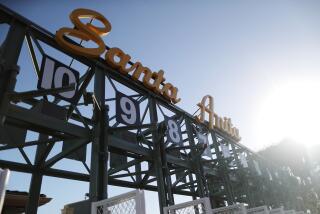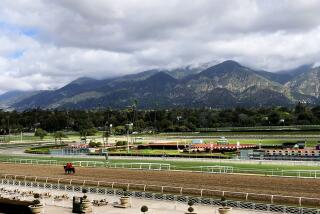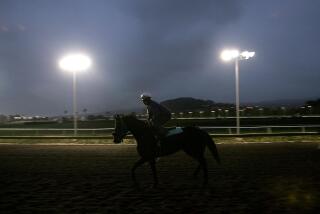In Siena, victory is everything
Siena, Italy — IN a scene that harks back to the Middle Ages, 50,000 spectators in this city’s packed, fan-shaped piazza explode with emotion as horses representing rival neighborhoods burst from their starting positions.
Bareback atop the steeds are 10 colorfully clad jockeys. Riding with them are enormous stakes for themselves and their civic patrons.
For three breathtaking, mud-spattered laps, the riders exhort their charges in a race known as the Palio -- a competition of the city’s districts, or contrade. As the winner crosses the finish line, pandemonium erupts; members of the winning contrada leap from the stands, and the multitudes burst into tears, cheers and song. In the soft Tuscan twilight, the ancient square itself seems to shake and swell with excitement.
The Palio, which my family witnessed last year, is one of Europe’s grand spectacles. Held twice each summer, it embodies this fabled city’s history, passions and lore. But to the people of Siena, it is something more.
“The Palio is not a sporting competition; it’s not a horse race,” says Chiara Savoi, a Siena native and member of the contrada known as Lupa, or She-wolf.
“It’s something we feel inside. Is the horse race 75 seconds long? Yes. But if you win the Palio, you are the boss of the town. You can do whatever you want against the enemy contrada. It’s the glory. The power. The tradition. The Palio is the soul of Siena.”
To experience the Palio is to share, at least vicariously, in that glory and tradition. For fiercely proud Sienese, victories are so enduring that births, marriages and deaths are marked by who won that year’s Palio. And the competition is so cutthroat that in the days before the race, fears abound of horses being drugged or jockeys bribed, and both are closely guarded.
During a honeymoon trip nearly two decades earlier, my wife, Katherine, and I found ourselves in Siena’s main piazza one evening when the sound of song suddenly emanated from somewhere in the city’s narrow streets. A boisterous procession marched into the square. We learned this was the Palio’s winning contrada -- still celebrating a month later. We vowed one day to see the event itself.
We returned with our 11-year-old daughter, Julia, for the full Palio experience. After arriving two days before the August race, we watched two trials and attended a dinner with 900 members of the Lupa contrada.
By the eve of the Palio, Julia was so caught up in it that she told me, “I’ve got butterflies in my stomach.”
*
The race’s origins
MEDIEVAL Siena stretches over three steep hills in the heart of the Chianti region of Tuscany. It’s renowned for its Gothic cathedral as well as its Piazza del Campo, whose paving stones were laid in 1347.
Twice a year, the piazza is transformed. A dirt track is laid around the perimeter in the days before the Palio, always July 2 and Aug. 16. The race -- a tribute to the Madonna, Siena’s patron saint -- is of uncertain origin but dates back as far as the 13th century.
The Palio itself is a silk banner dedicated to the Virgin Mary. Each year, Siena artists compete to design the flag for the July contest, and international artists do the same for the August race.
The city has 17 contrade. There isn’t room for all to race, so 10 compete in each Palio. If a contrada is not selected in July or August, it is included the following year. The remaining slots are filled by lottery.
The contrade are like extended communal families. Each is a separate city ward. In the Middle Ages, each had its own military to defend Siena from rival Florence. Today, each has a church, a public square and a headquarters. The most common way to join a contrada is to be born or baptized into it.
Every major event -- from birth and baptism to marriage and death -- is marked within the contrada. Most of the contrade are named after animals and other creatures -- Caterpillar, Dragon, Eagle, Forest, Giraffe, Goose, Owl, Panther, Porcupine, Ram, Shell, Snail, Tower, Turtle, Unicorn and Wave, as well as the she-wolf, which derives from the legend of Remus and Romulus.
The day before the Palio, Luca Luchini, Lupa’s president, is visibly tense. We meet at the contrada’s headquarters, where Lupa’s horse is stabled.
People pay $50 to $60 annually to belong to the contrada. Most of Lupa’s nearly 2,000 members reside beyond the ward’s boundaries. “The people who live outside the town feel the contrada inside themselves,” says Luchini, a 56-year-old banker.
During a tour of Lupa’s museum, Luchini shows us the banners his contrada has won. I ask if he has a favorite. “The next one,” he replies with a smile.
That evening, we join 900 members of Lupa and their friends for dinner. We’re seated at 50-foot-long tables with wooden chairs. Periodically, participants burst into Lupa’s anthem. Noting that all the contrade sing in tune, Katherine remarks, “That’s what happens in a country raised on opera.”
*
Glory ... and money
FOUR days before the race, the contrade captains choose the 10 horses for the Palio from among 30 to 40 candidates. Through a drawing, each horse is then assigned to a contrada. As the horses are placed in stalls in front of city hall, contrade faithful cheer or groan in reaction to the luck of the draw.
The contrade vie for the best jockeys, hired from throughout Italy. The riders can switch contrada until noon of the day of the race. “Don’t fall in love with the jockey,” Savoi warns us, “because the jockey is a traitor.”
No one better personifies the Palio than Andrea De Gortes, renowned as “Aceto,” or Vinegar. De Gortes, Italy’s most famous jockey, raced in 58 Palios, for 14 different contrade, winning a record 14 times before retiring as “the king of the piazza” in 1992 at 49, an unusually advanced age for a jockey.
Wiry and olive-skinned, he now lives in a villa amid wheat fields in the Tuscan hills outside Siena. Over a savory breakfast of pecorino cheese, salami sandwiches and Sardinian wine, De Gortes emphasized that it took him five years to master the nuances of the race.
“Sixty percent is good luck, 20% is the jockey and 20% is the horse,” he says.
The contest is challenging. The piazza was built as a town square, not a racetrack. The horses want to hew toward the short columns on the inside of the track for protection, which the jockeys must strain to prevent because running too close can be perilous. Years ago, a young jockey was paralyzed after falling from his horse. Others have broken arms or legs. A riderless horse finishing first is still declared the winner.
Betting on the Palio is forbidden, but money plays a big role. “The Palio is like life,” De Gortes says. “If you start with money, you have more opportunity to live better and, in this case, to win.”
For the race, each contrada operates with a budget largely of pledges by its members. Based on the total pledged, the jockey is authorized to promise large sums to other jockeys to disrupt a rival horse or to steer clear of his own. Only the winning contrada has to make good on these offers. The cost of victory could be almost $2.5 million, De Gortes says.
The jockeys also are well paid. De Gortes estimates that a hot jockey riding for an affluent contrada could earn more than $300,000 to run and twice that sum if he wins.
De Gortes, who has entertained filmmaker Mel Gibson and British Prime Minister Tony Blair at his trophy-filled farmhouse, makes no apologies for his motivation.
“I have run for the glory,” he says, “and the money.”
*
‘Deafening silence’
EARLY in the morning of Palio day, throngs begin to line the piazza to grab the best free spots. Meanwhile, the winding streets around the campo, or square, bustle with growing crowds.
The Tower contrada, denied the Palio for 44 years, is the favorite. Its jockey, Luigi Bruschelli, is riding the majestic Berio -- the combination that won for Caterpillar the month before and for Turtle the previous August.
By 5 p.m., the piazza is a sea of humanity. People gaze out from balconies and windows surrounding the square. Men, women and children file in through the single entrance; this process ends when police push the last of the crowd into the center of the campo as though squeezing commuters into a Japanese subway train.
Before the race comes the slow and solemn procession of contrade members. Bringing up the rear is the victory wagon, pulled by four white oxen and carrying the black-and-white flag of Siena and the coveted Palio.
Contrade scarves wave throughout the piazza as the 10 horses enter the track from city hall. Each rider is given a whip made of ox tendon. I notice a jockey lean over to another, apparently seeking to make a deal.
The campo becomes absolutely still. “Listen to the silence,” Savoi says. “It’s deafening.”
The crowd roars as the starting positions are announced. The first slots are best. Nine horses position themselves between two ropes. They maneuver into the right order even as they push to gain an edge for a fast start.
Meanwhile, the 10th stays back. This jockey must decide when to start the race by taking off from behind. He will wait until a rival’s horse is distracted. This jockeying invariably takes far longer than the race itself; it has been known to go on for more than an hour.
Then, suddenly, they’re off. Lupa’s horse jumps out front. But it’s soon overtaken by Berio, who pulls ahead and sets the pace. The scene is at once frenzied and frozen. For 73 glorious seconds, it feels as if we are at the center of the universe.
Even before Berio crosses the finish line, Tower faithful stream from the stands to embrace the animal and the jockey. We see grown men crying, for joy and sorrow, including the handler for another contrada’s horse as he leads his beaten steed away.
Lupa finishes 10th. But our Julia is by no means discouraged. Still adorned in her Lupa scarf, she participates in the ritual of sucking on a flashing pacifier. This is a symbol of the tenderness felt for the Palio banner, also known in Siena as cittino, or baby.
Tower’s all-night celebration is just beginning as we stand in the still-buzzing piazza on this unforgettable summer evening. Julia is already looking ahead.
“Can we come back next year?” she asks.
*
(BEGIN TEXT OF INFOBOX)
Stay the course
GETTING THERE:
From LAX, Air France, KLM and Lufthansa all offer connecting service (change of plane) to Florence. Restricted round-trip fares begin at $790. Siena is about an hour’s drive from Florence.
TELEPHONES:
To call the numbers below from the U.S., dial 011 (international dialing code), 39 (country code for Italy), 0577 (city code for Siena) and local number.
GOING TO THE PALIO:
You can stand inside the piazza for free but you’ll have to arrive early and remain in place for hours. Reserved seats are available through the Siena Tourist Board (www.terresiena.it) for $247 to $469 based on current exchange rates. If you’re seeking a guide, try Chiara Savoi; telephone 270623, or e-mail at [email protected].
WHERE TO STAY:
Palazzo Ravizza, 34 Pian dei Mantellini; 280462, www.palazzoravizza.it. Handsome and small. Doubles during Palio start at $148.
Certosa di Maggiano, 82 Strada di Certosa; 288180, www.certosadimaggiano.com. A 14th century monastery transformed into an upscale country villa. Rooms during Palio from $493.
TO LEARN MORE:
Italian Government Tourist Board, 2400 Wilshire Blvd., Suite 550, Los Angeles, CA 90025; (310) 820-1898, www.italiantourism.com.
Vacanze Senesi, 45900, www.bookingsiena.it, works with the Siena Tourist Board.
-- Alan C. Miller


